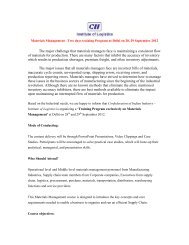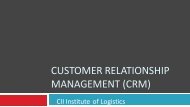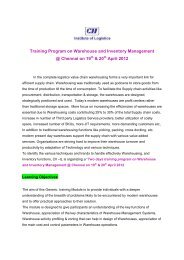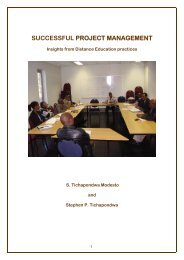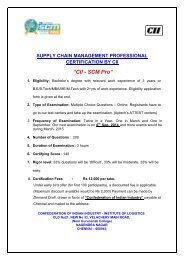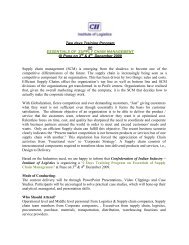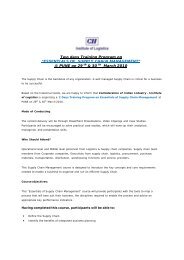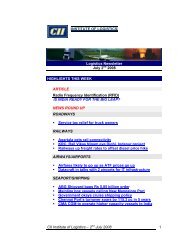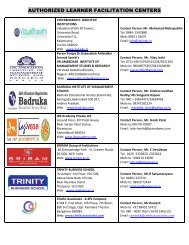Untitled - CII Institute of Logistics
Untitled - CII Institute of Logistics
Untitled - CII Institute of Logistics
You also want an ePaper? Increase the reach of your titles
YUMPU automatically turns print PDFs into web optimized ePapers that Google loves.
FUNDAMENTALS OF LOGISTICS<br />
Types <strong>of</strong> Selective Inventory Control Techniques<br />
ABC Analysis<br />
Relates to the annual usage cost <strong>of</strong> a particular item. Generally 10 per cent <strong>of</strong> items account for nearly<br />
70 per cent <strong>of</strong> usage value, another 20-30 percent may account for 20 per cent <strong>of</strong> usage value and the<br />
balance 60 – 70 per cent accounts for 10 per cent <strong>of</strong> the usage value. Items are classified as per their<br />
usage value.<br />
‘A’ items costs approximately 60 – 70 per cent <strong>of</strong> the total inventory cost while they are less in number.<br />
‘B’ items cost 20-30 per cent <strong>of</strong> the total inventory cost while ‘C’ class items are greater in number and<br />
carry less than 10 per cent <strong>of</strong> the cost <strong>of</strong> the entire inventory.<br />
VED Analysis<br />
Related to the Vital, Essential, and Desirable status <strong>of</strong> inventory items. As the term implies, certain<br />
parts and items are considered to be vital for meeting operational requirements and this aspect is taken<br />
into consideration while making a forecast. While making a forecast, certain items and parts, which are<br />
considered as vital for meeting operational requirements, are considered. The modified version <strong>of</strong> this<br />
is the ABC analysis. VED analysis, takes into consideration both the value and criticality <strong>of</strong> each item.<br />
Continuous review is necessary for high value and critical items and thus is ordered in low quantities.<br />
Low value, least critical items are reviewed periodically and ordered in large quantities and have lower<br />
safety stock requirements.<br />
SAP analysis<br />
Refers to Scarce, Available and Plenty analysis which allows to build into provision forecasts. The<br />
ordered quantity is governed by the scarcity factor. The guideline for procurement policy decisions<br />
would be the limitations in supply or the obsolescence <strong>of</strong> the firm in the near future.<br />
FSN analysis<br />
The Fast, Slow or Normal analysis determines the consumption pattern <strong>of</strong> each item. However, a<br />
realistic picture for procurement action will not be available from a consumption pattern where the<br />
production run is slowed down due to various other reasons.<br />
SDE Classification<br />
Classification based on the availability <strong>of</strong> an item. S items are scarce items, which needs to be imported<br />
and thus take a long time to obtain. D items are difficult to obtain, and E items are easily obtainable.<br />
Inventory Planning Models:<br />
<strong>CII</strong> INSTITUTE OF LOGISTICS 28<br />
Website: www.cii.in / www.ciilogistics.com







